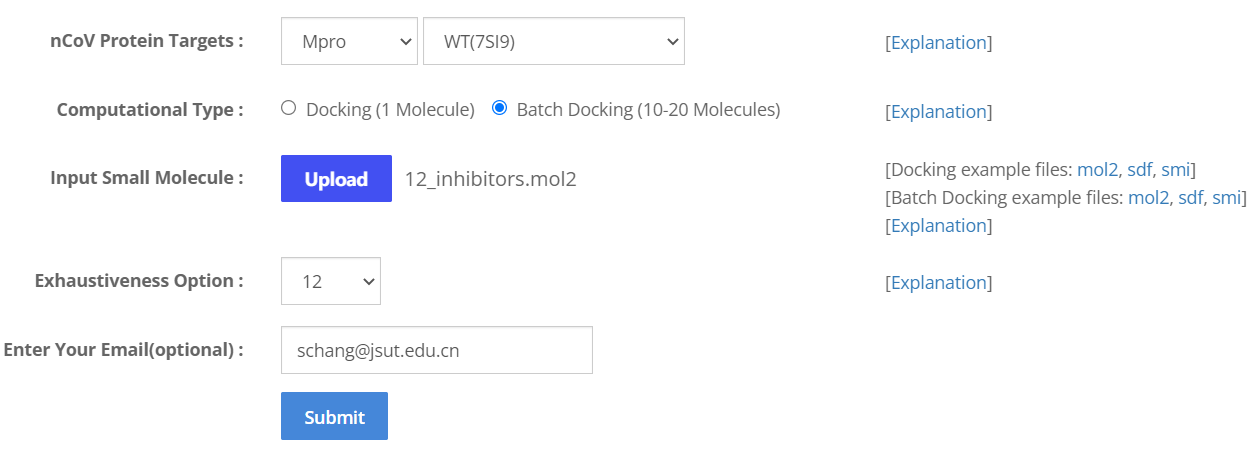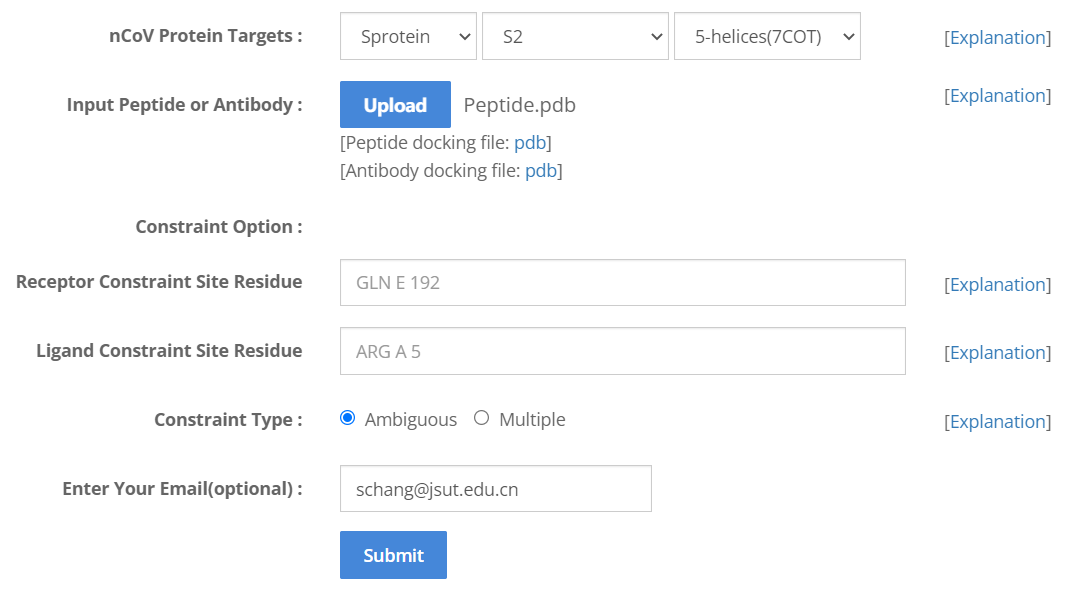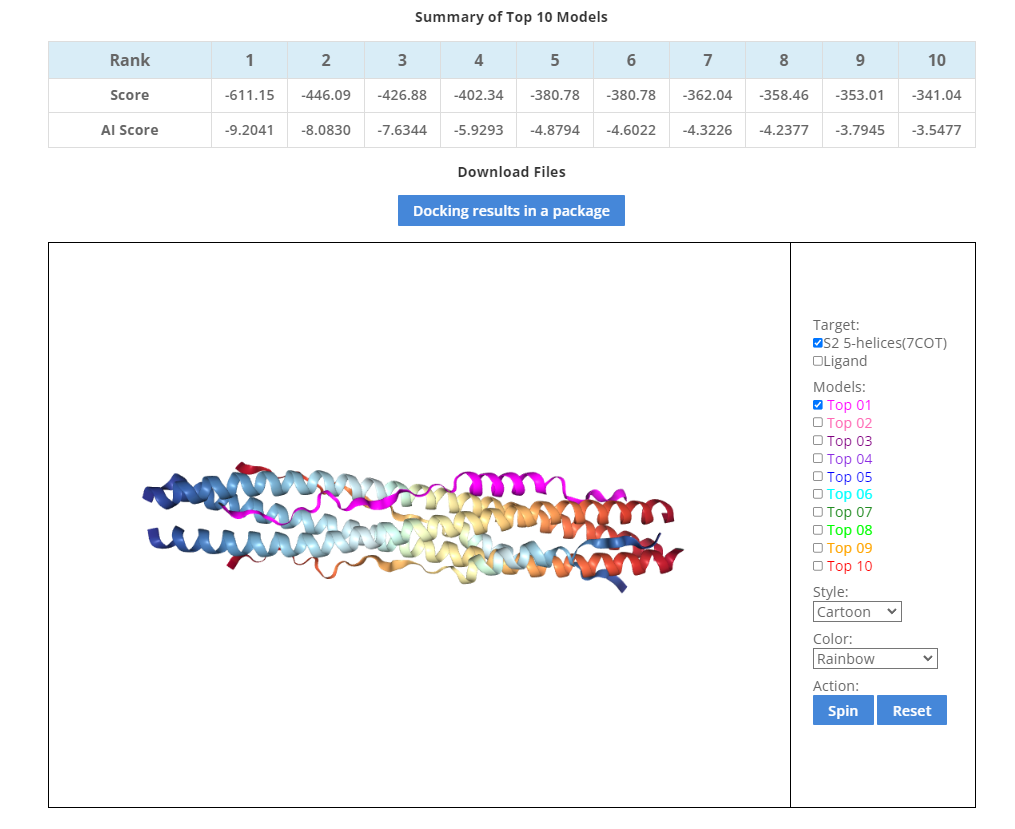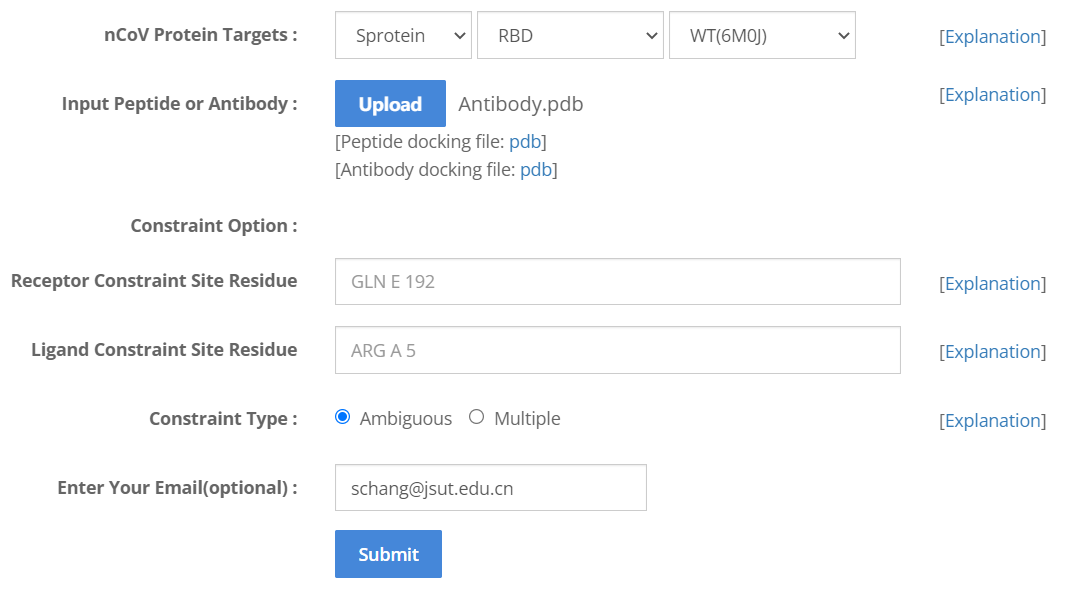Tutorial for nCoVDock2 (COVID-19 Docking Server 2.0)
1. Docking small molecule to COVID-19 protein targets
1.1 Provide input files for protein-small molecule docking
You need to choose one of the COVID-19 targets and upload small molecules in strict smi, mol2 and sdf formats. Open Babel (License: Open Babel Official Page) is used for format transformation or 3D coordinate generation for the uploaded files. Autodock Vina (License: AutoDock Vina Official Page) is used as docking engine. You should choose the computational modules before you upload the small molecule files: if “Docking” is selected, only one small molecule should be uploaded, and top 10 binding modes will be displayed on the result page. If “Batch Docking” is selected, 10-20 molecules should be uploaded, and the top 10 molecules ranked by the scoring function will be displayed on the result page. If you have 1-10 molecules need to be evaluated, then you have to upload the molecules one by one and choose the “Docking” module. Exhaustiveness is a parameter of the docking search. Increasing this value will increase the time linearly and decrease the probability of not finding the minimum exponentially. An email will be sent to your email address, containing a directed link to access you docking results.

1.2. Retrieve the jobs
After your job completes, you could enter the job ID to access the result page.

Alternatively, you can access the docking results by the corresponding link in your email. The download url is provided as: http://ncovdock2.schanglab.org.cn/index/result/index.php?job_id=*************
When the job is completed, the server will send an email to the user. By default, the server only displays the top 10 models. The selected COVID-19 protein target is renamed Input_R.pdb. The top 10 models are named TopL1.pdb-TopL10.pdb, respectively. The models can be visualized in 3D by NGL (License: NGL). The scored file is named as Score.dat. For small molecule docking, ligand poses docked against a receptor by AutoDock Vina are re-scored by RF-Score-v4 (License: RF-Score-v4 software Page). The re-scored file is named as Score_pKd.dat. You can view and download your docking results from the result page.

2. Docking peptide or antibody to COVID-19 protein targets
2.1 Provide input files for peptide or antibody docking
You need to choose the COVID-19 protein target and upload ligand (peptide or antibody) proteins in strict pdb format. The PDB checker, such as Molprobity, should be used to check the file and fix any potential errors in pdb file before you upload it. For peptide and antibody docking, CoDockPP (CoDockPP Server) is used as docking engine.

2.2 Specify the binding site [optional]
The protein docking server can perform global docking and site-specific docking to predict the binding mode between two proteins. You can enter one constraint residue on the receptor interface and another one on the ligand interface.
The binding site residues are provided in the text box as follows

The example shows that GLN192 in chain E of the receptor and ARG5 in chain A of ligand are chosen for site constraints. User could enter one residue into either the receptor box or the ligand box, or he could enter one residue into receptor box and one into the ligand box simultaneously. If only one residue on the ligand or receptor is defined, then the conformations with the specific residue on the interface of the complex are retained. When the user defines one residue on the receptor and the other one on the ligand simultaneously, then he needs to choose the constraint type: ambiguous constraint or multiple constraints. When the ambiguous constraint is selected, the conformations are retained with at least one selected residue on the interface. When the multiple constraints are selected, the conformations are retained with both of the residues on the interface.
Introduction of Docking Examples
1. Example of small molecule docking
Main protease (Mpro) and its approved drug, PF-07321332 are taken as an example for small molecule docking. Main protease is selected as the protein target. The “Docking” mode is selected and its approved drug, PF-07321332 in PDB 7SI9 is uploaded as the input ligand (the examples of input files in mol2, sdf and smi formats can be downloaded here: PF-07321332.mol2, PF-07321332.sdf, PF-07321332.smi). Exhaustiveness option is 12. The input interface is shown as follows.

Results are available on the page by the following link: http://ncovdock2.schanglab.org.cn/index/result/index?job_id=6223399da0040. For the top rank binding modes, the predicted binding energy of Top 1 was -8.8 kcal/mol, and the L_RMSD was 1.27 Å. The output interface is shown as follows.

2. Example of small molecule batch docking
Main protease and its inhibitors are taken as an example for small molecule batch docking. Main protease is selected as the protein target. The “Batch Docking” mode is selected as the computational type and its 12 inhibitors are uploaded as the input ligands (the examples of input files in mol2, sdf and smi formats can be downloaded here: 12_inhibitors.mol2, 12_inhibitors.sdf, 12_inhibitors.smi). Exhaustiveness option is 12. The input interface is shown as follows.

Results are available on the page by the following link: http://ncovdock2.schanglab.org.cn/index/result/index?job_id=640b0a7cacb7a. The output interface is shown as follows.

3. Example of peptide docking
The post-fusion state of S2 segment of spike protein is taken as an example for peptide docking. A 5-helices structure extracted from the post-fusion state of 6-helices S2 is selected as the protein target. The pdb file of ligand peptide was uploaded (the example of input file in pdb format can be downloaded here: Peptide.pdb) and the default global docking mode was chosen. The input interface is shown as follows.

Results are available on the page by the following link: http://ncovdock2.schanglab.org.cn/index/result/index?job_id=63fd6c6878824. For the top rank binding modes, the scoring value of Top 1 binding mode was -611.15, and the L_RMSD was 0.93 Å. The output interface is shown as follows.

4. Example of antibody docking
The spike protein and antibody are taken as an example for antibody docking. The spike protein is selected as the protein target. The pdb file of antibody (7BZ5) was uploaded (the example of input file in pdb format can be downloaded here: Antibody.pdb) and the default global docking mode was chosen.The input interface is shown as follows.

Results are available on the page by the following link: http://ncovdock2.schanglab.org.cn/index/result/index?job_id=63fd6c810edd6. For the top rank binding modes, the scoring value of Top 1 binding mode was -440.88, and the L_RMSD was 1.14 Å. The output interface is shown as follows.

If you have any suggestions or questions, please Contact Us.